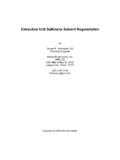Transcription of Improving the distillation energy network - Energy …
1 Improving the distillation Energy networkEnergy costs are the largest percentage of a hydrocarbon plant s operating expenditures. This is especially true of the distil-lation process, which requires substantial Energy consumption. Concerns over recent high costs and economic pressures continually emphasise the need for efficient distillation design and operation without a loss of performance. This article illustrates how Energy -efficient design can be applied in a distillation unit through optimisation between the distillation column and heat network system. Through a case study, a successful retrofit of an aromatics distillation unit is discussed. Detailed retrofit activities, including complex heat network evaluation, process simula-tion modelling and Energy -friendly, high-performance distillation equip-ment implementation, are described.
2 Strategies for Improving thedistillation Energy network As continuous distillation requires simultaneous heat input and removal (thus requiring significant Energy consumption), complex heat integration becomes more common for modern distillation units to improve unit Energy efficiency. Since a distillation column s degree of separation and enthalpy balance influence each other, it is critical to evaluate and optimise the distilla-tion column and heat exchanger networks together in order to maximise plant are numerous strategies to improve the Energy efficiency of distillation processes, with the amount of improvement through each strategy varied according to Energy -efficient design applied to the refit of a distillation unit was achieved through optimisation between the distillation column and heat network systemSOUN HO LEE GTC TechnologyKWANG GIL MIN GS Caltex Corporationprocess conditions.
3 The following are common strategies that can be applied to practical Energy improvement temperature Feed temperature is a major factor influencing the overall heat balance of a distillation column system. Increments in the feed enthalpy can help reduce the required Energy input from the reboiler at the same degree of separation. Installing a feed preheater is a very common process option to minimise reboiler heat duty. If the feed preheater can be integrated with other valuable process streams (as a heating medium), overall Energy efficiency of the distillation system can be improved further. However, increasing the feed temperature does not always improve the over-all Energy efficiency of a distillation unit. Excessive feed temperature increments can cause a significant amount of flash of heavy key and non-key components at the distilla-tion column feed zone.
4 In this case, a higher amount of reflux stream is necessary to maintain required overhead distillate purities. This augmented reflux ratio thus requires a higher boil-up ratio. Overall Energy efficiency is eventu-ally Therefore, careful review of the feed temperature and phase is critical to minimise the overall Energy consumption of the distillation unit. Feed location Improper feed location of a distilla-tion column can also increase the reflux/boil-up ratio and Energy consumption. An ideal feed location is a section of the distilla-tion column where the composition of column internal liquid traffic is similar to feed stream composition. In this case, the composition gradi-ent between feed stream and distillation internal fluids is mini-mised. In actual operation of the distillation column, feed composi-tions are often changed from the original design conditions.
5 In cases of significant deviation, discrepancy between column internal liquid composition and feed stream composition can increase, which results in a non-optimum feed loca-tion. Therefore, evaluating feed location is an essential step for successful distillation unit Energy improvement. Inter-condensers and inter-reboilersAdding inter-condensers and/or inter-reboilers can help improve overall Energy efficiency. Pumparound, one of the inter- condenser concepts, has been widely applied to numerous petro-leum multi-product fractionators. On the other hand, implementing an intermediate reboiler can reduce the main reboiler duty. As the required temperature of an inter-mediate reboiler is lower than that of the main reboiler, this strategy may allow heat integration with other valuable heat sources that are not as costly or not fully utilised in the operating pressure Relaxation of the column top oper-ating pressure decreases the distillation column s temperature profile and results in a lower reboiler duty.
6 It has been observed Revamps 2013 3 4 Revamps 2013 function of the xylene column is to separate the feed mixture to xylene components and heavier C9+ components. This column has two different feed sources. The reformate splitter bottom stream and the toluene column bottom stream (which belongs to the aromatic extraction unit) are introduced as the xylene column bottom feed stream. The bottom feed stream is split equally and charged to two different feed trays. The reformate splitter s bottom stream is treated at the clay towers to eliminate traced olefin components before charging to the xylene column.
7 Meanwhile, the deheptaniser bottom stream (from the xylene isomerisation unit) is charged as the xylene column top feedstock. This stream is also split and introduced to three different feed trays. The xylene column overhead vapour stream is split into three parallel streams. Two vapour streams are utilised as the heat source of the extract column reboiler and the raffinate column reboiler, respectively. The condensed xylene column overhead liquid streams are returned to the xylene column receiver. The other vapour stream is supplying heat to the xylene column overhead steam generator, which produces #250 steam. The condensed overhead liquid stream is also returned to the xylene column receiver. The over-head distillate of the xylene column is sent to the paraxylene recovery unit.
8 In the xylene column reboiler circuit, the xylene column bottom reboiler inlet stream is first trans-ported to the other two distillation column reboilers as heating medi-ums. After providing heat to these reboilers, the xylene column bottom streams are combined and intro-duced to the furnace-type xylene column reboiler. In the paraxylene recovery unit, the xylene components from the xylene column are separated through the adsorption process. The pre-separated extract stream from the adsorption process is charged to the extract column in order to separate paraxylene from that numerous commercial distilla-tion columns have been operated with lower operating pressures than their original design values. However, this strategy is not appli-cable to columns operated under an atmospheric pressure range.
9 Column overhead circuit pressure drop and condenser temperature approaches both heavily influence feasibility. In addition, column pressure reduction expands vapour traffic and pushes the limits of existing distillation equipment. Column pressure drop Reducing column pressure drop can lower reboiler duty at the same degree of separation. The amount of reboiler duty saving relies on operating pressure and enthalpy balance. This strategy is generally feasible when the distillation column is operated under vacuum pressure range. Meanwhile, pres-sure drop improvement does not often provide noticeable Energy savings in high-pressure range distillation efficiency improvement Column efficiency improvement can reduce the reflux/boil-up ratio at a given degree of separation. This strategy can be delivered by increasing the number of theoreti-cal stages and/or enhancing the efficiency of distillation equipment.
10 The feasibility can be gauged by a dedicated sensitivity analysis. Constructing a column efficiency curve with a reflux ratio is one of the core tools for sensitivity analysis. A typical curve is shown in Figure 1. This curve visualises column efficiency sensitivity and Energy -saving gain. The curve can be categorised by three district zones: steep, moderate and flat Column efficiency improvement is usually very feasible when the reflux ratio falls into the steep sensitivity zone and at ratios considerably in excess of the mini-mum reflux ratio. In this scenario, even the small addition of stages, or an increase in distillation equip-ment efficiency, can enhance overall column separation with significant Energy reductions. Improvement gain is diluted in the moderate sensitivity zone. Further detailed feasibility study is necessary through economic analy-sis.









